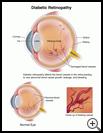
Diabetes: Retinopathy
________________________________________________________________________
KEY POINTS
- Diabetic retinopathy is damage to the blood vessels in your retina caused by long-term high blood glucose and high blood pressure.
- If you are diagnosed with diabetic retinopathy, you need to work with your healthcare provider to get your blood glucose under control with diet, exercise, and possibly medicine. Careful control of your blood glucose level, blood pressure, and cholesterol will help delay and possibly prevent vision loss.
- Treatment may also include eye medicine, laser treatment, or surgery.
________________________________________________________________________
What is diabetic retinopathy?
Diabetic retinopathy is a problem with the blood vessels in your retina. The retina is the lining at the back of your eye that senses light coming into the eye. The retina has tiny blood vessels that can be damaged by long-term high blood glucose and high blood pressure. Diabetic retinopathy is the most common cause of permanent blindness from diabetes.
What is the cause?
Diabetes is a problem with the way the body uses digested food for energy. Your body changes the food you eat into sugar. Blood carries the sugar to the cells where it is used for energy. When you have diabetes, sugar cannot get into the cells and stays in the blood. This causes high blood glucose. High blood glucose levels damage small blood vessels and cause them to break and leak.
As your condition worsens, some of the blood vessels close off, which keeps oxygen from getting to the retina. When this happens, new blood vessels form to make up for the lack of oxygen. These new blood vessels are weak and they can bleed and form scar tissue. This scar tissue can pull the retina away from the back of the eye, which is called retinal detachment. If this happens, it can cause a loss of vision.
You are more likely to develop retinopathy if you have diabetes for a long time or if your blood glucose is often out of control.
What are the symptoms?
At first, diabetic retinopathy may not cause symptoms. As the problem gets worse, symptoms may include:
- Blurry vision
- Floaters, which are black spots or cobweb-like shapes
- Temporary or permanent blindness
How is it diagnosed?
Your eye care provider will ask about your symptoms and medical history and do exams and tests such as:
- An exam using a microscope with a light attached, called a slit lamp, to look closely at the front and back of your eye
- An exam using drops to enlarge, or dilate, your pupils and a light to look into the back of your eyes
- An eye test in which a camera takes pictures of the blood vessels inside your eye after dye is injected into a vein in your arm.
- An eye pressure test, which uses a small puff of air that is blown against your open eye or a device that briefly touches your eye after it is numbed with drops to measure the pressure inside your eye
How is it treated?
If you are diagnosed with diabetic retinopathy, you need to work with your healthcare provider to get your blood glucose under control with diet and exercise. Most people with diabetes also need to take medicine. Careful control of your blood glucose level, blood pressure, and cholesterol will help delay and possibly prevent vision loss.
If your retina has been damaged by bleeding, swelling, and scar tissue inside the eye, you may need surgery or laser treatment to save your vision.
Medicine may be injected into the eye to decrease the growth of new blood vessels and decrease swelling.
How can I take care of myself?
Follow the full course of treatment your healthcare provider prescribes. Ask your healthcare provider:
- How and when you will get your test results
- How long it will take to recover after surgery or procedures
- If there are activities you should avoid and when you can return to your normal activities
- How to take care of yourself at home
- What symptoms or problems you should watch for and what to do if you have them
Make sure you know when you should come back for a checkup. Keep all appointments for provider visits or tests.
How can I help prevent diabetic retinopathy?
Follow your diabetes treatment plan so that you have fewer problems. A healthy lifestyle may help. For example:
- Eat a healthy diet and keep a healthy weight.
- Stay fit with the right kind of exercise for you.
- Control your blood glucose, blood pressure, and cholesterol levels.
- If you smoke, try to quit. Talk to your healthcare provider about ways to quit smoking.
- If you want to drink alcohol, ask your healthcare provider how much is safe for you to drink.
If you have diabetes, see your eye care provider every year, even if you do not have problems with your vision. Let your eye care provider know that you have diabetes and what medicines you take. If you have eye changes due to diabetes, your eye care provider may want you to have exams more often.

